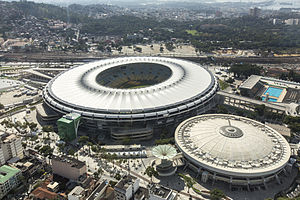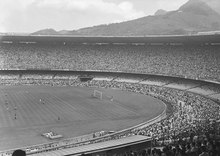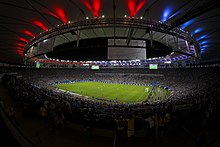Maracanã
| Estádio Jornalista Mário Filho | |
|---|---|
| Maracanã | |

|
|
| Exterior view of the Maracanã, June 2013 | |
| Data | |
| place |
|
| Coordinates | 22 ° 54 '43.8 " S , 43 ° 13' 48.7" W |
| owner | State of Rio de Janeiro |
| operator | State of Rio de Janeiro |
| start of building | August 2, 1948 |
| opening | June 24, 1950 |
| First game | Carioca selection - Paulista selection 1: 3 |
| Renovations | 1999–2000, 2005–2007, 2010–2013 |
| surface | Natural grass |
| architect |
Raphael Galvão Pedro Bastos Orlando Azevedo Antônio Dias Carneiro |
| capacity | 78,838 seats |
| Capacity (internat.) | 74,738 seats |
| playing area | 110 m × 75 m |
| Societies) | |
| Events | |
The Maracanã (in Portuguese Estádio do Maracanã , in German-speaking countries also Maracanã Stadium ), officially Estádio Jornalista Mário Filho , is a football stadium in the Brazilian metropolis of Rio de Janeiro . When it was completed in 1950, it was the largest football stadium in the world with a capacity of up to 200,000 spectators. After numerous modernizations, the capacity is now 78,838 spectators.
The Maracanã is located in the Complexo Esportivo do Maracanã ( Portuguese for Maracanã Sports Complex ), which also includes the Maracanãzinho multi-purpose hall and the Parque Aquático Júlio Delamare swimming stadium .
Name of the stadium
The Maracanã was named Estádio Jornalista Mário Filho after the death of the journalist Mário Filho in 1966 . At the end of the 1940s, Filho and his newspaper O Mundo Sportivo were strongly committed to ensuring that the main stadium for the 1950 World Cup was not in Jacarepaguá , in the western foothills of Rio de Janeiro, but in the Maracanã district , just a few kilometers west of the city center, on the abandoned grounds of the Derby Clube racecourse . His main adversary here was the journalist and city councilor Carlos Lacerda , later aspirant for the presidency and governor of the state of Guanabara .
history
After Brazil won the bid for the Soccer World Cup in 1950 , the Brazilian government decided to build a new stadium that would seat 200,000 spectators. The plans for the stadium were drawn up by seven Brazilian architects (Miguel Feldman, Waldir Ramos, Raffael Galvão, Oscar Valdetaro, Orlando Azevedo, Antônio Dias, Pedro Carneiro and Paulo Bastos Bernardes). Work on the stadium began on August 2, 1948 with the laying of the foundation stone and took a total of two years.
Opening and World Cup 1950
The stadium's opening game took place on June 16, 1950 between the Rio de Janeiro All-Stars and São Paulo All-Stars and ended with a 3-1 win for the home team. Valdir Pereira scored the first goal. However, the stadium still presented itself as a construction site. There was a lack of sanitary facilities and a press box. Despite the unfinished state, however, FIFA allowed the stadium to be played. On June 24, 1950, in front of 81,000 spectators, the first World Cup match between Brazil and Mexico took place.
Maracanaço
| Maracanã: Biggest Audience - Football | ||||
| 1. | 07/16/50 | 199,854 | WM | Brazil 1-2 Uruguay¹ |
| 2. | 03/21/54 | 195,513 | WMQ | Brazil 4-1 Paraguay |
| 3. | 12/15/63 | 194,603 | SRJ | Fluminense FC 0-0 CR Flamengo³ |
| 4th | 08/31/69 | 183.341 | WMQ | Brazil 1-0 Paraguay |
| 5. | 04/04/76 | 174,770 | SRJ | CR Flamengo - CR Vasco da Gama 1: 1 |
| 6th | 06/15/69 | 171,599 | SRJ * | CR Flamengo - Fluminense FC 2-3 Botafogo FR - AA Portuguesa 0-0 |
| 7th | 12/22/74 | 165.358 | SRJ | CR Flamengo - CR Vasco da Gama 0-0 |
| 8th. | 3/9/77 | 162,764 | WMQ | Brazil 6-0 Colombia |
| 9. | 12/6/81 | 161,989 | SRJ | CR Flamengo - CR Vasco da Gama 2: 1 |
| 10. | 05/06/73 | 160,342 | SRJ * | CR Flamengo - CR Vasco da Gama 1-0 Bangu AC - Madureira 2-1 |
|
WM = World Championship, WMQ = World Cup qualification,
|
||||
On July 16, 1950, the last game of this World Cup between Brazil and Uruguay was played in the stadium. The favored Brazilians were surprisingly defeated 1: 2 and thus missed the World Cup title, which was already believed to be safe, which is still considered a national trauma and for which the term Maracanaço was coined in Brazil . How many spectators saw the game in the stadium can no longer be determined today. The number 173,850 is considered certain, and 199,854 or even 203,851 viewers are often given.
The years after the 1950 World Cup
On March 21, 1954, a new official attendance record was set in the game between Brazil and Paraguay: 183,513 spectators saw the victory of the home team. In 1965, 17 years after construction began, the stadium was finally completed. After the 1950 World Cup, the Maracanã was mainly used by the four major soccer clubs from Rio de Janeiro: CR Vasco da Gama , Botafogo FR , CR Flamengo and Fluminense FC . The stadium was also used for cup finals, including the Copa do Brasil and the Campeonato Carioca . In September 1966, the Brazilian journalist Mário Rodrigues Filho, who was largely involved in the construction of the stadium, died. In his honor, the stadium was officially named Estádio Jornalista Mário Filho , although the name Maracanã will continue to be used.
1990s and 2000s
When a grandstand collapsed on July 19, 1992, three spectators died and 50 were injured. After the disaster, the stadium capacity was greatly reduced, with all standing room removed. In 1998 the Maracanã was classified as a national landmark, so it cannot be demolished. In 2000, it hosted the final of the first FIFA Club World Cup between CR Vasco da Gama and Corinthians São Paulo , which Corinthians won on penalties.
After its 50th birthday in 2000, it was renovated for the Pan American Games to be held in Rio de Janeiro in July 2007 . The interior with the playing field was lowered by 1.40 meters and new seats were installed. During the renovation work, only about 44,000 fans found space in the formerly largest stadium in the world, which was reopened in January 2007 with 82,238 seats.
In recent years, the Maracanã has been used for the games of the Brazilian national soccer team and various clubs in the city.
Conversion for the 2014 World Cup and 2016 Olympics
The venue was completely renovated with a view to the 2014 World Cup , the 2016 Summer Olympics and the 2016 Paralympics . The cost of the renovation amounted to just under 316 million euros. The installation of new press stands and boxes reduced the stadium's capacity for international matches to 74,738 spectators. Due to this work, games in the stadium were suspended for almost three years from the beginning of September 2010. On May 30, 2013, the national soccer teams of Brazil and England played the first international match after the reopening, which ended 2-2.
After the Olympics
In the months following the end of the Olympic Games, the stadium was in a very poor condition and could no longer be used. The lawn was withered, and the seats and televisions had been torn out and stolen. Debt with the local energy supplier also meant that the electricity was temporarily switched off. During this time, tours of the stadium were completely discontinued. The reason for these developments is said to have been a legal dispute over responsibility for the maintenance of the stadium after the Olympic Games between the operator at the time and the Olympic Organizing Committee.
In spring 2017, the stadium was temporarily reopened for three Copa Libertadores games after Flamengo had paid for repairs and unpaid bills.
In 2017 the operation of the stadium was to be taken over by the French group of companies Groupe Lagardère . However, the company withdrew from its offer after a few months due to legal uncertainties. In March 2019, the state of Rio de Janeiro took over management of the stadium. At the Copa América 2019 in Brazil, the Maracanã served as the final stadium, among other things.
In 2020 the stadium will celebrate its 70th birthday. Flamengo Rio de Janeiro would like to operate the venue for the next 35 years. In recent years there has been repeated talk of building your own stadium. Club President Rodolfo Landim rejects this. The new building would have a worse location and Flamengo would be burdened with repaying debts and interest for decades. A stadium with 60,000 seats would cost around 212 million euros. Should Flamengo take over the Maracanã, Landim would like to change the capacity. The seats behind the goals are to become standing room areas. The now 79,000 places would be around 94,000 places. 15,000 cheaper seats would be created for poorer football fans. The issue of standing room is part of the negotiations. The changes could take place after the end of the 2020 Copa Libertadores in November at the earliest . The Maracanã is the final venue of the competition.
Confederations Cup 2013
| date | round | home | guest | Result |
|---|---|---|---|---|
| June 16, 2013 | Preliminary round |
|
|
1: 2 (1: 1) |
| June 20, 2013 | Preliminary round |
|
|
10: 0 (4: 0) |
| 30th of June 2013 | final |
|
|
3: 0 (2: 0) |
2014 World Cup matches
The following games took place in the stadium during the World Cup:
| Sun., June 15, 2014, 7:00 p.m. (Mon., June 16, 2014, 00:00 a.m. CEST) - Group F | |||
|
|
- |
|
2: 1 (1: 0) |
| Wed., June 18, 2014, 4:00 p.m. (9:00 p.m. CEST) - Group B | |||
|
|
- |
|
0: 2 (0: 2) |
| Sun., June 22, 2014, 1:00 p.m. (6:00 p.m. CEST) - Group H. | |||
|
|
- |
|
1: 0 (0: 0) |
| Wed., June 25, 2014, 5:00 p.m. (10:00 p.m. CEST) - Group E. | |||
|
|
- |
|
0: 0 (0: 0) |
| Sat., June 28, 2014, 5:00 p.m. (10:00 p.m. CEST) - round of 16, 2 | |||
|
|
- |
|
2: 0 (1: 0) |
| Fri., July 4, 2014, 1:00 p.m. (6:00 p.m. CEST) - quarter-finals 2 | |||
|
|
- |
|
0: 1 (0: 1) |
| Sun., July 13, 2014, 4:00 p.m. (9:00 p.m. CEST) - final | |||
|
|
- |
|
1: 0 a.d. |
Olympic Games 2016
In Maracanã the opening and closing ceremonies were for both the 2016 Summer Olympic Games and for the Paralympic Summer Games in 2016 instead. In addition, in the Olympic soccer tournaments, both men and women played a semi-final and the final in the stadium.
| date | round | home | guest | Result |
|---|---|---|---|---|
| 16 Aug 2016 | Semi-finals (women) |
|
|
0: 0 a.d., 3: 4 i. E. |
| 17th Aug 2016 | Semi-finals (men) |
|
|
6: 0 (3: 0) |
| 19 Aug 2016 | Final (women) |
|
|
1: 2 (0: 0) |
| Aug 20, 2016 | Final (men) |
|
|
1: 1 (1: 0) new, 5: 4 in connection E. |
Various events
Although the Maracanã is mainly used to host football matches, cultural events also take place in the stadium on a regular basis.
Concerts
- The performances of Frank Sinatra (1980), Kiss (1983), Tina Turner (1987) and Paul McCartney (1991) each drew around 180,000 people to the stadium.
- The group a-ha (1991 at Rock in Rio II) even set a record number of visitors for concerts in stadiums with around 195,000 people. This is also mentioned in the 2004 Guinness Book of Records .
- Other artists were: Udo Jürgens (1974), Sting (1987), Bon Jovi (1990), Madonna (1993, 2008), Rolling Stones (1995), Backstreet Boys (2001), The Police (2007), Ivete Sangalo (2006 ).
Others
- In 1980 Pope John Paul II celebrated a papal mass in the Maracanã during his visit to Brazil .
Quote
"Only three people have silenced the Maracanã with a single movement: Frank Sinatra, Pope John Paul II and me."
panorama
See also
Web links
- Website for the renovation of the stadium
- Maracanã on Rio2016.com
- Superintendência de Desportos do Estado do Rio de Janeiro (website of the operator SUDERJ)
- Series of images. In: stadionwelt.de
- Luciano Pasqualini: Best Attendances in Brazil (Maiores públicos de futebol no Brasil). In: RSSSF and RSSSF Brazil , October 7, 2010
- LISTA: As dez bandas que mais lotaram o Maracanã. In: EGO , May 19, 2008
Individual evidence
- ↑ http://www.fifa.com/classicfootball/stadiums/stadium=214/index.html
- ↑ Maracanã fica mais moderno sem abrir mão de sua história. In: estadao.com.br. Retrieved September 23, 2012 .
- ^ Estadio do Maracana - Rio de Janeiro. FIFA , accessed September 5, 2012 .
- ↑ Nova Fronteira, Rio de Janeiro, 2000, John Walter Foster Dulles: Carlos Lacerda: a vida de um lutador
- ↑ El fútbol vuelve al histórico Maracaná tras nueve meses de espera. (No longer available online.) In: El País (Uruguay) . January 22, 2006, archived from the original on January 9, 2009 ; Retrieved October 20, 2008 (Spanish).
- ↑ Soccer Hall: 1950 FIFA World Cup. (No longer available online.) In: soccerhall.org. Archived from the original on March 30, 2009 ; accessed on March 23, 2007 (English).
- ^ Estadio do Maracana - Rio de Janeiro . In: fifa.com (English).
- ↑ Roland Zorn: Maracana, symbol of the new Brazil. In: FAZ , July 30, 2011, accessed on July 30, 2011.
- ^ Video "Rio six months after the games - sadness instead of Olympic glamor" - morning magazine. (No longer available online.) In: Das Erste. February 21, 2017, archived from the original on February 22, 2017 ; accessed on February 21, 2017 .
- ↑ WORLD: Maracanã: Final stadium of the 2014 World Cup now belongs to the Rios cats . January 18, 2017 ( welt.de [accessed June 28, 2019]).
- ^ Lagardère Sports backs out of the Maracana deal. May 16, 2017. Retrieved June 28, 2019 (UK English).
- ↑ Governo do Rio anuncia rompimento do contrato atual de concessão do Maracanã. Retrieved June 28, 2019 (Brazilian Portuguese).
- ↑ Capacity increase planned for Maracanã. In: stadionwelt.de. February 13, 2020, accessed February 13, 2020 .
- ^ Rüdiger Falksohn: FOOTBALL: Dribbling on the equator. In: Der Spiegel . January 3, 2005, accessed September 5, 2012 .





